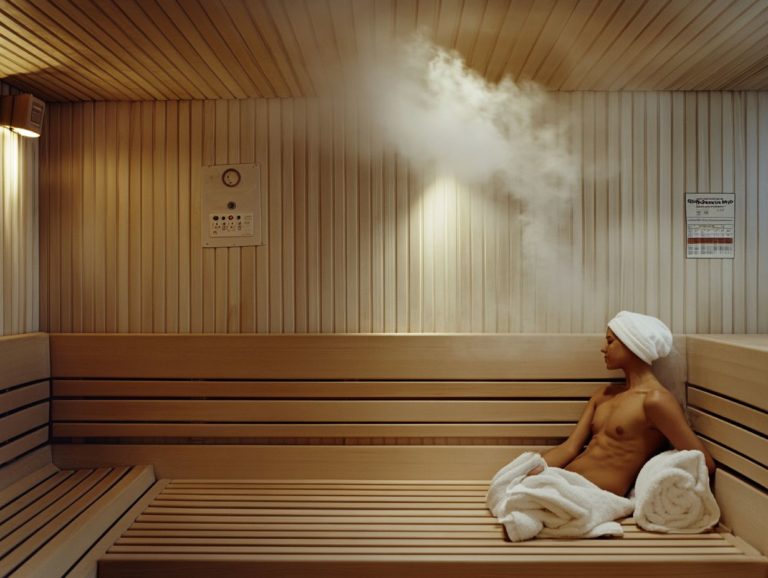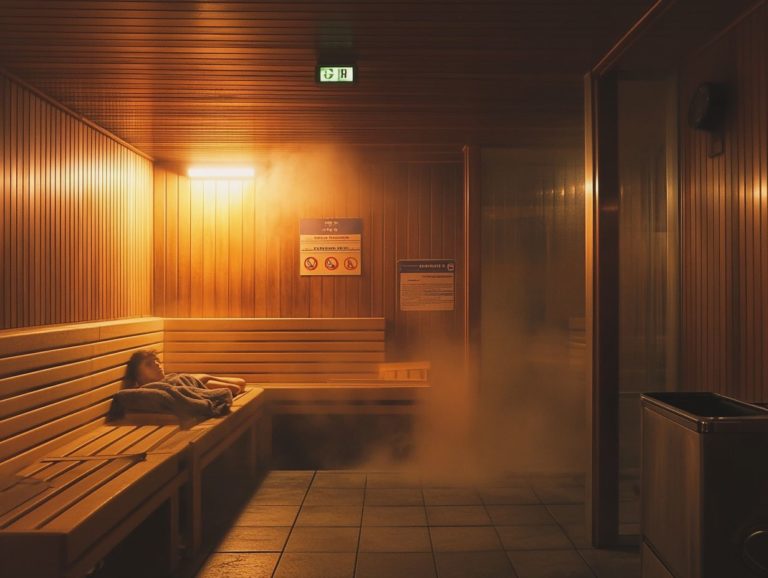Sauna Safety: Creating a Safe Space
Saunas have long been celebrated for their many physical and mental health benefits, offering a peaceful escape that revitalizes both body and mind!
As you indulge in a sauna experience, it’s important to consider a variety of safety aspects. This article delves into the key elements of sauna use, outlining potential risks and offering guidelines for safe sessions, as well as tips for creating an inviting and well-designed sauna environment.
It also highlights special precautions for people who need extra care, such as children, pregnant women, and the elderly, and provides insights on recognizing and managing any adverse reactions.
Engage with this content to uncover how you can fully enjoy the advantages of sauna use while placing safety at the forefront.
Contents
- Key Takeaways:
- The Benefits of Sauna Use
- Understanding Sauna Safety
- Creating a Safe Sauna Space
- Essential Sauna Safety Tips
- Sauna Safety for Different Populations
- Potential Side Effects of Sauna Use
- Frequently Asked Questions
- What’s the safe temperature for enjoying your sauna?
- Is it safe to use a sauna while pregnant?
- What should I wear inside a sauna for safety?
- How long should I stay inside a sauna for a safe experience?
- Are there any health conditions that may make sauna use unsafe?
- What are some general safety tips to keep in mind while using a sauna?
Key Takeaways:
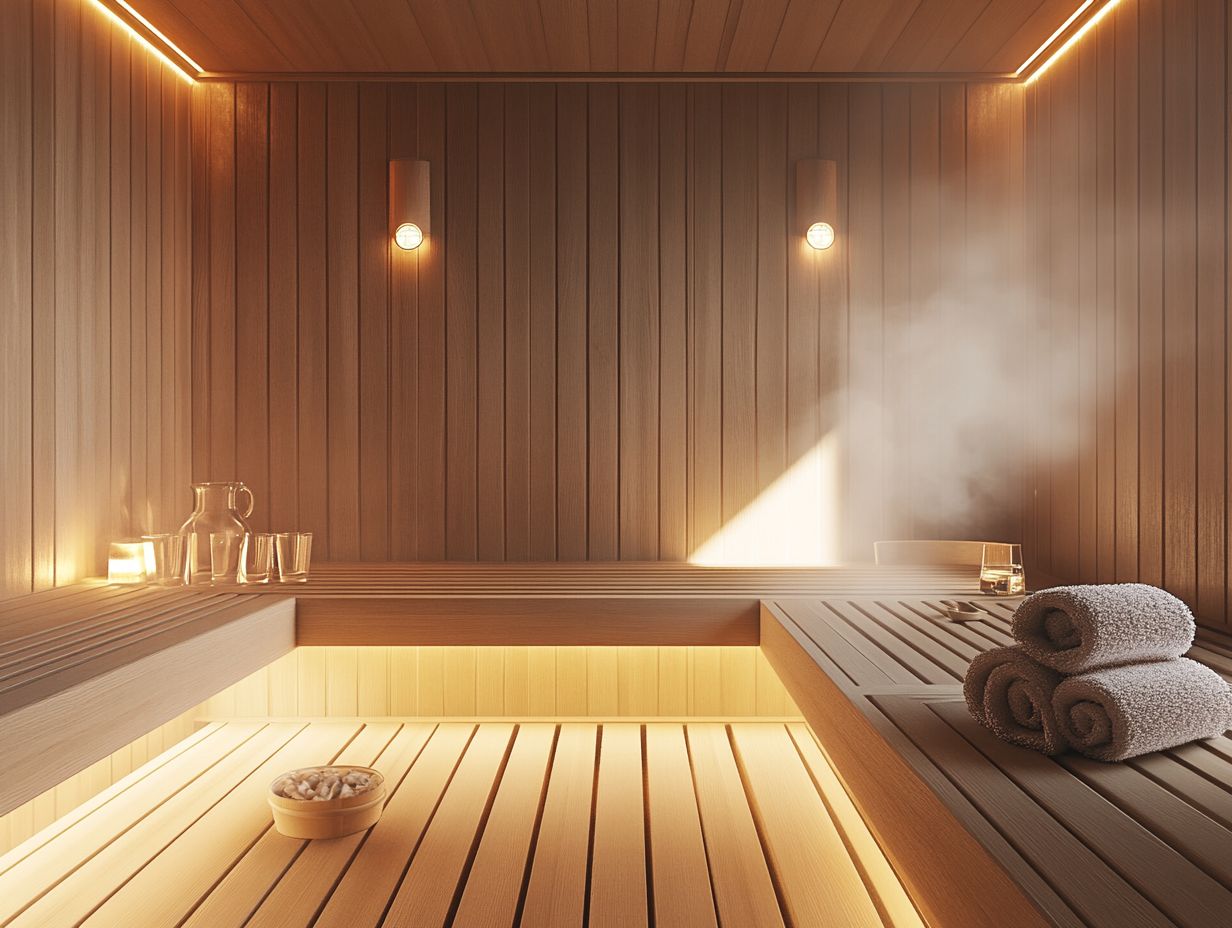
- Saunas offer numerous physical and mental health benefits, but it’s important to understand and prioritize safety precautions.
- Design and maintenance of a sauna space, along with following guidelines for use, are key factors in creating a safe environment.
- People who need extra care, such as children, pregnant women, and the elderly, require additional considerations for safe sauna use, and potential side effects should be recognized and addressed promptly.
The Benefits of Sauna Use
The benefits of sauna use go far beyond simple relaxation; they offer a wealth of physical and mental health advantages that make them a valuable addition to your wellness routine. Embracing regular sauna bathing can significantly enhance your cardiovascular health, promote detoxification by flushing out toxins, and provide relief from conditions such as arthritis.
The gentle warmth soothes your muscles, alleviates stress, and elevates your overall mood, making it a cherished practice among fitness enthusiasts and health-conscious individuals alike.
Physical and Mental Health Benefits
Saunas offer a wealth of physical and mental health benefits, positioning themselves as an essential element of a holistic wellness approach.
When you engage in regular sauna sessions, you can significantly enhance your cardiovascular health. The improved circulation and reduced blood pressure are vital for maintaining a healthy heart. The high temperatures work wonders in detoxifying your body by promoting sweating, which helps eliminate the toxins that can accumulate over time.
You might also discover that spending time in a sauna leads to muscle relaxation, easing tension after those intense workouts. And let s not forget about the mental health advantages; the tranquil atmosphere serves as a perfect sanctuary for stress relief, lifting your mood and contributing to an overall sense of well-being.
Understanding Sauna Safety
Understanding sauna safety is crucial to fully enjoy its benefits and protect your health. By adhering to established sauna guidelines, you become informed about common hazards, such as dehydration and overheating, which can jeopardize your health and well-being.
Ensuring proper supervision, particularly in public settings, and paying close attention to posted safety protocols can significantly reduce the likelihood of incidents, allowing you to enjoy a safe and rejuvenating experience.
Common Risks and How to Avoid Them
Common risks associated with sauna use include dehydration and overheating, yet these can be effectively managed with the right precautions.
It’s essential to recognize that prolonged exposure to high temperatures can result in serious health issues, particularly when your body’s fluid balance is disrupted. To prevent dehydration, make it a habit to hydrate thoroughly before and after your sauna sessions, ensuring you replenish any lost fluids.
Equally important is monitoring your time in the sauna; limiting your sessions to 15-20 minutes can help maintain a safe body temperature. If you’re in a vulnerable population like the elderly or those with pre-existing health conditions, having someone supervise your sauna use can provide a vital safety net, allowing for assistance should any adverse effects occur. For more detailed guidelines, check out sauna safety: the link between comfort and safety.
Creating a Safe Sauna Space
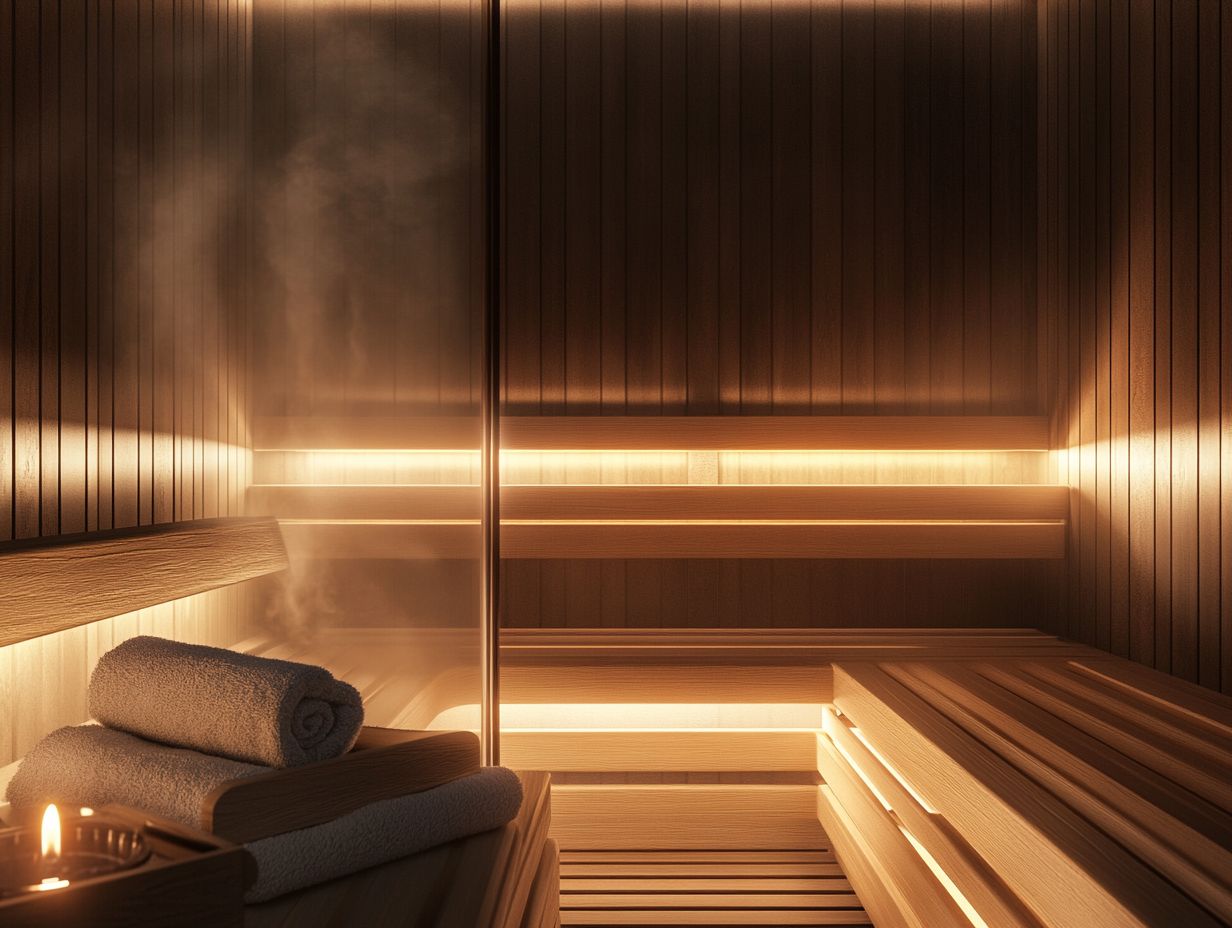
Creating a safe sauna space requires careful attention to both physical design and ongoing maintenance. This ensures that every user enjoys safety and comfort. When selecting the ideal sauna be it a traditional sauna, an infrared sauna, or a steam room consider essential design elements.
For example, make sure the sauna door opens outward and that all wiring work is done by a licensed electrician. Regular maintenance is also crucial, as it helps minimize potential hazards and keeps your sauna inviting and secure.
Design and Maintenance Considerations
Design and maintenance are essential for ensuring the safety and functionality of your sauna. Effective sauna design goes beyond aesthetics; it includes key elements such as good insulation to keep heat in and adequate ventilation for effective air circulation.
The layout of the space should allow for maximum relaxation while adhering to safety standards.
Regular maintenance is vital. This includes routine inspections of electrical components by a licensed electrician to prevent hazards. Understanding materials that can withstand high temperatures and humidity can also help you extend the lifespan of your sauna, ensuring a safe and rejuvenating experience for years to come.
Essential Sauna Safety Tips
Taking precautions for sauna use is crucial for maximizing health benefits while minimizing potential risks. By following sauna guidelines like keeping a safe temperature and staying hydrated with water you ll boost your sauna experience significantly.
Supervision is crucial, especially for inexperienced users and vulnerable individuals. This ensures a secure environment for everyone enjoying the sauna.
Guidelines for Sauna Sessions
To enjoy your sauna sessions, start by maintaining the appropriate sauna temperature and ensuring proper hydration.
Limit each session to about 15-20 minutes, especially if you re new to this invigorating ritual. Staying hydrated before, during, and after your sauna visit is essential, as the heat can lead to significant fluid loss, particularly for those with high blood pressure or other health risks.
Since sauna sessions can affect people differently, supervise anyone with pre-existing health conditions or young children to ensure their safety. It’s also crucial to understand sauna safety, so pay attention to how you feel during the session; if any discomfort arises, stepping out for some fresh air is a smart move to maintain your well-being.
Sauna Safety for Different Populations
Sauna safety is especially important for various populations, particularly those with high blood pressure or existing heart conditions. They may need specific considerations before entering the heat.
By understanding tailored safety guidelines for these groups, you can fully embrace the benefits of the sauna while minimizing unnecessary risks. Effective supervision and pre-use assessments are essential for a safe and enjoyable experience for everyone involved, particularly when considering sauna safety across different cultures.
Special Considerations for Children, Pregnant Women, and Elderly Individuals
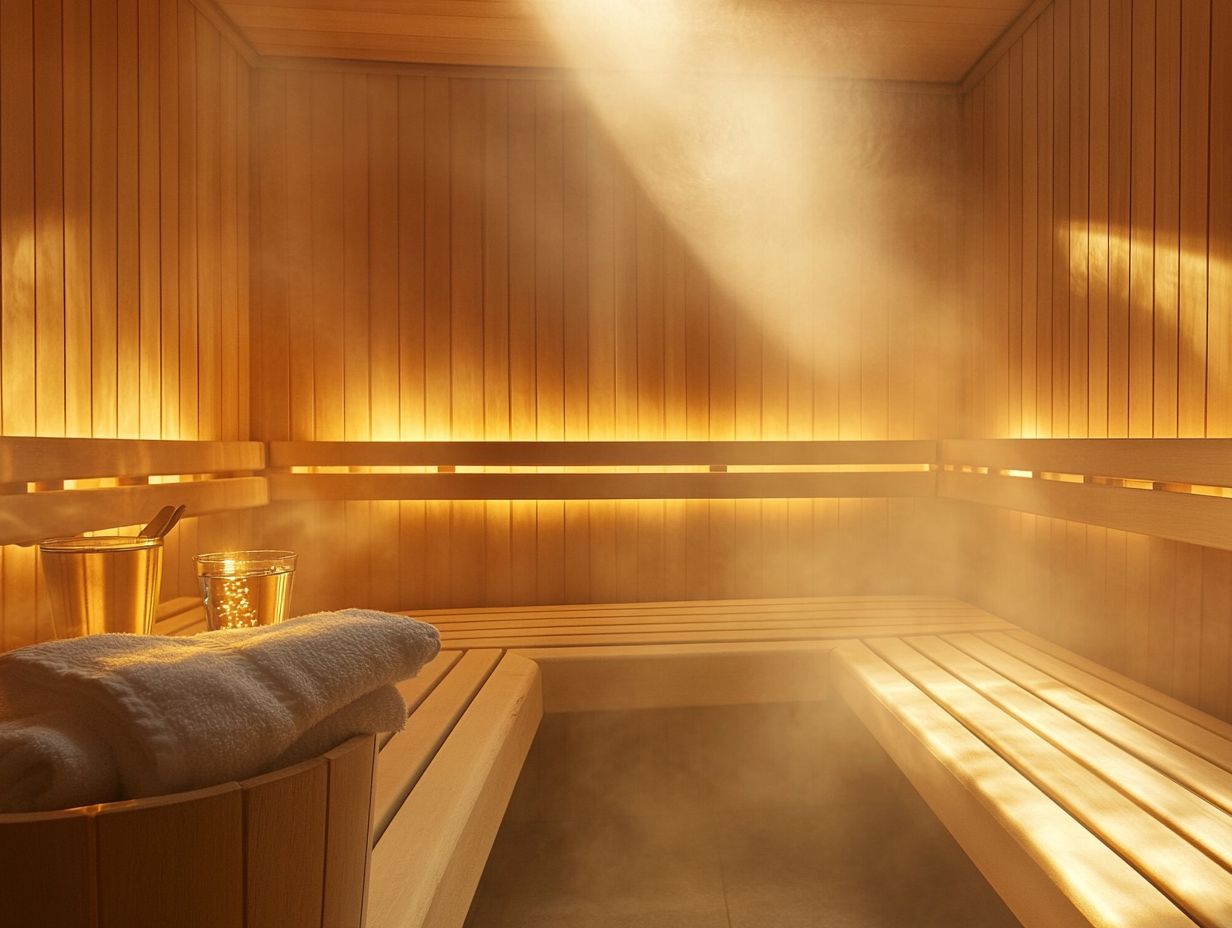
In terms of sauna safety, special considerations are essential for children, pregnant women, and elderly individuals. These groups are particularly vulnerable to health risks.
For your little ones, children under the age of 5 should avoid sauna use altogether. If you have older children, always ensure they re accompanied by an adult during their sauna time.
Pregnant women should definitely consult their healthcare provider before using a sauna. High temperatures can lead to overheating and dehydration, which pose serious risks.
For older adults, high temperatures can be harder to tolerate. Opt for shorter sessions and low heat options to ensure comfort.
Hydration is key for everyone, regardless of age. Be sure to drink water before and after your sauna sessions to prevent not having enough water in your body.
It’s essential to keep an eye on younger and older users to ensure their safety and comfort throughout the sauna experience.
Potential Side Effects of Sauna Use
While enjoying the many benefits of sauna use, be mindful of potential side effects and health risks that might arise. Common concerns include dehydration and overheating, especially for those with high blood pressure or heart conditions.
By understanding these risks, you can take necessary precautions for a safe and enjoyable sauna experience.
Recognizing and Addressing Adverse Reactions
Recognizing and addressing adverse reactions during your sauna experience is essential for safety and comfort.
The sauna environment can sometimes lead to unexpected symptoms. Be attentive to signs like dizziness, excessive sweating, and a rapid heart rate for a positive experience.
If you feel lightheaded or notice clamminess, it s crucial for anyone nearby to help guide you out of the heat immediately.
Staying hydrated is another key factor in preventing overheating. Having experienced users around can be invaluable. They should be ready to respond promptly in case of an emergency.
If serious symptoms arise like fainting or confusion seeking medical assistance without delay is absolutely critical.
Frequently Asked Questions
What’s the safe temperature for enjoying your sauna?
The recommended temperature for a safe sauna experience is between 150-190 degrees Fahrenheit. It’s important to listen to your body and not exceed your comfort level.
Is it safe to use a sauna while pregnant?
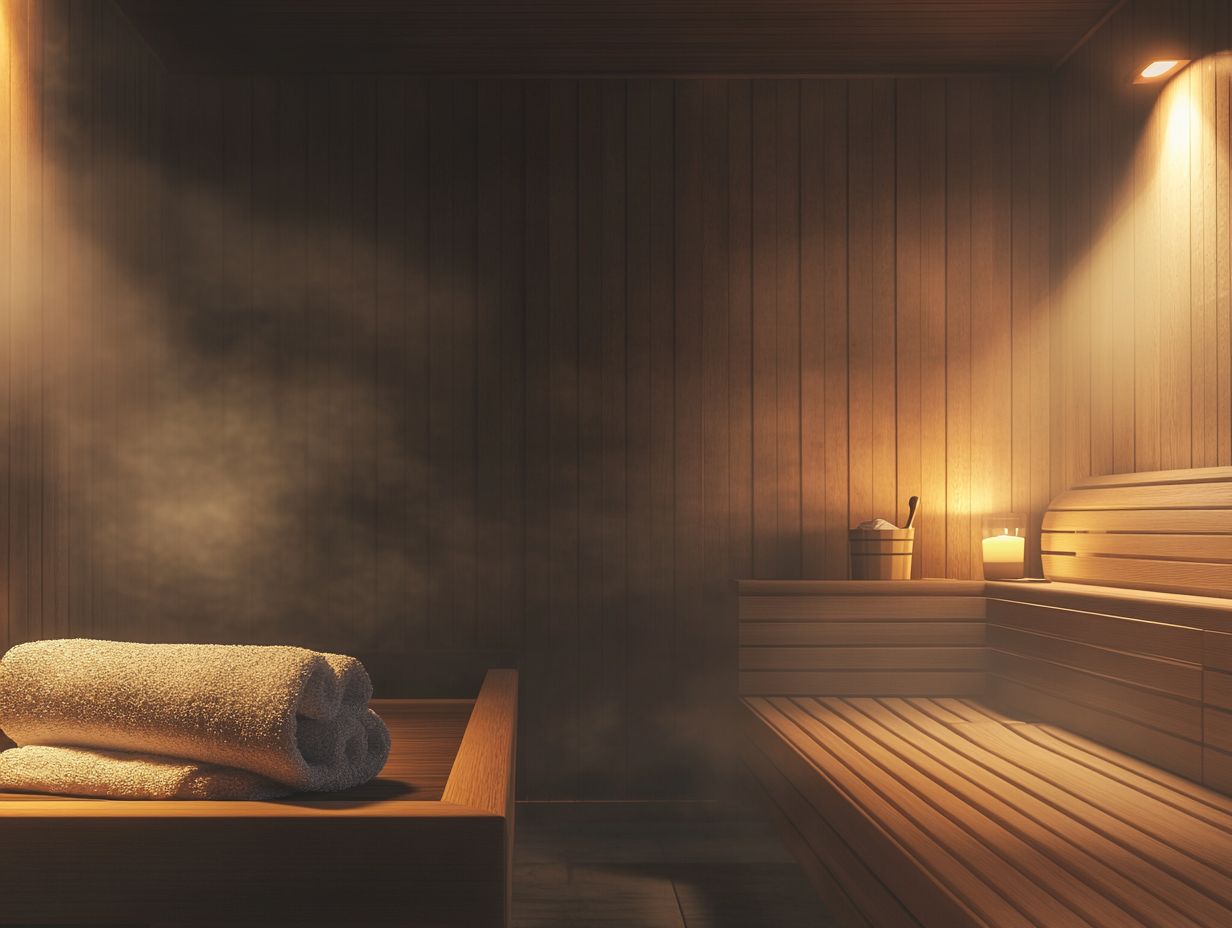
It is not recommended to use a sauna while pregnant. High temperatures can cause discomfort and potential harm to the unborn baby. Always consult with a doctor before using a sauna during pregnancy.
What should I wear inside a sauna for safety?
It is recommended to wear loose, breathable clothing or a towel while inside a sauna. Avoid wearing jewelry or accessories that can get hot and cause burns.
How long should I stay inside a sauna for a safe experience?
The recommended time for a safe sauna experience is 10-15 minutes. Listen to your body and don t stay longer than what feels comfortable for you.
Are there any health conditions that may make sauna use unsafe?
Yes, some health conditions may make sauna use unsafe. These include heart conditions, high or low blood pressure, and dehydration. Always consult with a doctor before using a sauna if you have any underlying health concerns.
What are some general safety tips to keep in mind while using a sauna?
- Stay hydrated!
- Don t use the sauna if you feel unwell.
- Avoid alcohol before and during sauna use.
- Use caution when entering and exiting, as floors may be slippery.

